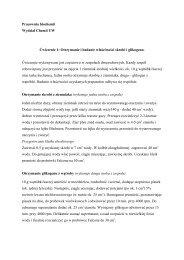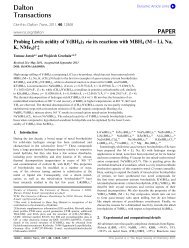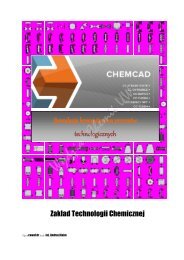Chem. Anal. (Warsaw), 53, 759
Chem. Anal. (Warsaw), 53, 759
Chem. Anal. (Warsaw), 53, 759
You also want an ePaper? Increase the reach of your titles
YUMPU automatically turns print PDFs into web optimized ePapers that Google loves.
762 Z. Hubicki, M. Wawrzkiewicz and A. Wo³owicz<br />
Figure 2. Spheron Salicyl (ion exchange capacity for Pd(II) ions 0.094 mmol g –1 resin)<br />
Figure 3. Spheron Oxine (ion exchange capacity for Pd(II) ions 0.57 mmol g –1 resin)<br />
Iglesias et al. [10] used macroporous polystyrene resin Duolite GT–73 for recovery<br />
of Pd(II) and Au(III) ions from chloride solutions. High sorption capacities for<br />
Au(III) ions (0.58 ± 0.03 mmol g –1 resin) and Pd(II) ions (0.262 ± 0.015 mmol g –1<br />
resin) were owed to the presence of thiol and sulfonic groups. As follows from the<br />
studies, the difference in sorption capacities resulted from the stoichiometry between<br />
gold and palladium ions and the functional groups of Duolite GT–73 (Au(III): —SH<br />
= 1:1, whereas for Pd(II): —SH = 1:2). Moreover, sorption of Pd(II) ions from<br />
1 mol L –1 HNO 3 resulted in 0.35 mmol g –1 resin ion exchange capacity. Desorption<br />
yields of Pd(II) and Au(III) ions from the selective ion exchanger was achieved using<br />
acidic thiourea solution with the chemical yields of 80% and 60%, respectively.<br />
The studies by Sánchez et al. [11,12] on modification of styrene–divinylbenzene<br />
copolymer by triisobutyl phosphine sulfide (TIBPS) (Fig. 4) in order to obtain the<br />
resin for concentration of precious metal ions are of significant importance. Donor O<br />
and S atoms present in the side chain of the modifier are responsible for selective<br />
separation of Au(III) and Pd(II) ions from chloride solution in the presence of Pt(IV),<br />
Rh(III), Ir(IV), Fe(III), Ni(II), Zn(II), and Cu(II) ions.







